Best Grow Lights For Cactus
Caring for cacti indoors can be tricky when sunlight is limited. These desert plants rely on bright, steady light to stay healthy and keep their shape. The best grow lights for cactus provide full-spectrum illumination that mimics natural sunlight, helping your plants thrive even in dim spaces.
You’ll learn how to choose lights that match your cactus’s needs, from brightness and color temperature to energy efficiency. With the right setup, you can support steady growth, prevent stretching, and keep your plants looking strong year-round.
This guide explores what to look for when shopping for grow lights, highlights top-rated options, and offers simple tips for setup and use. By understanding how different light types compare, you can create the ideal indoor environment for your cactus collection.
Key Factors When Choosing Grow Lights for Cactus
Choosing the right cactus grow light depends on several measurable factors. You need to match the light spectrum to what cacti use for photosynthesis, ensure proper brightness and intensity, use automation for consistent exposure, and position the lights at the correct distance and angle.
Light Spectrum Requirements for Cacti

Cacti need a full spectrum light that includes both blue and red wavelengths. Blue light supports compact, healthy growth and prevents stretching (etiolation). Red light is essential for efficient photosynthesis and encourages flowering and stem development.
LED grow lights for indoor plants often provide this full spectrum. Look for lights labeled as “sunlike” or “full spectrum LED.” Avoid narrow-band lights that only emit one color, as they can cause uneven growth.
You can compare options by checking the Kelvin rating:
- 5000K-6500K: Offers cooler, bluer light, often recommended for compact vegetative growth.
- 2700K-3500K: Offers warmer, redder light, used to support flowering.
A mix within this range usually works best for most indoor cacti.
Brightness and Intensity Considerations
Cacti evolved under strong sunlight, so they require high light intensity to thrive indoors. The brightness of a grow light is measured in PPFD (Photosynthetic Photon Flux Density). For cactus species, aim for a PPFD of 200–400 µmol/m²/s at the plant’s surface.
Use adjustable brightness if possible. Too much light can cause bleaching, while too little can lead to stretching and weak growth. LEDs with dimming controls let you fine-tune intensity based on the cactus type and distance from the light.
A simple test: if your cactus leans toward the light, it likely needs more intensity or closer placement.
Timer and Automation Features
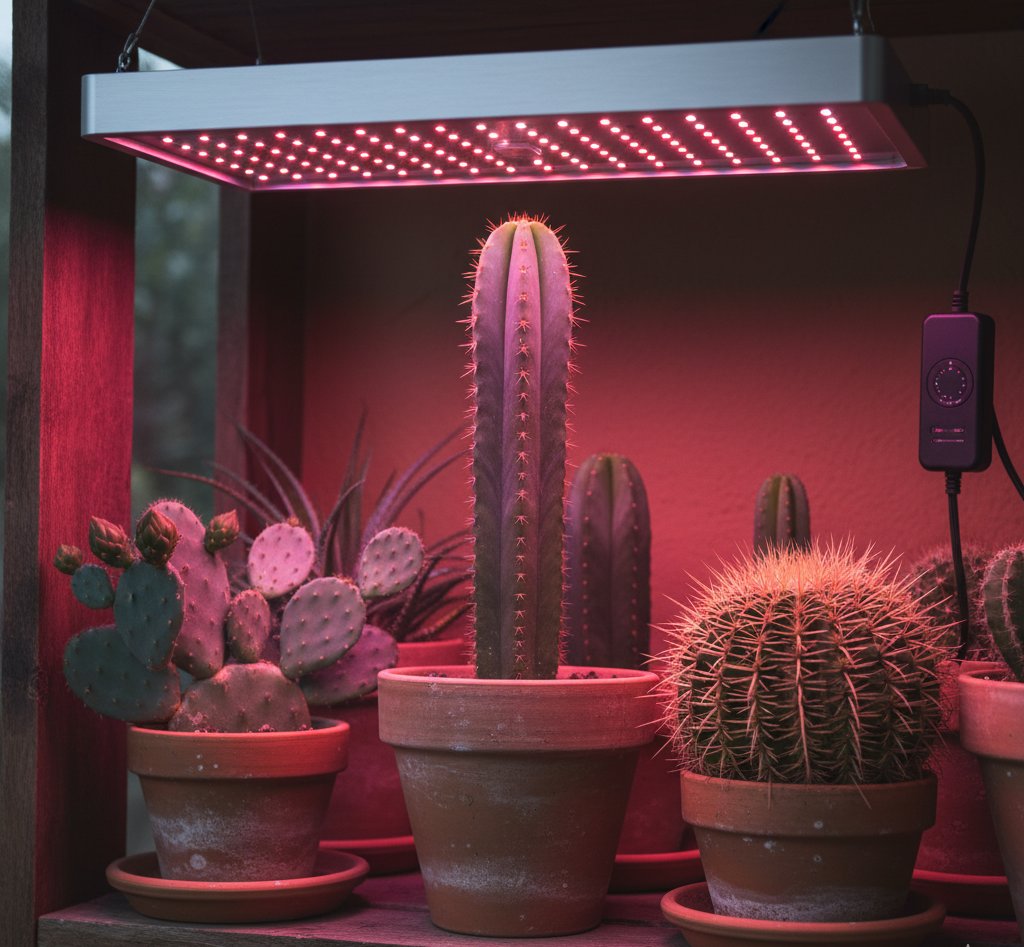
Timers help maintain a consistent photoperiod, which is the daily light cycle. Most cacti do best with 12–14 hours of light per day. Automating this schedule prevents overexposure and saves energy.
Many modern grow lights for indoor plants include built-in timers with 4-, 8-, or 12-hour settings. Some even offer programmable cycles or smart app control. These features keep your cactus on a stable routine that mirrors natural daylight patterns.
Automation also helps when you travel or forget to switch lights on and off manually.
Placement and Adjustability
Proper placement ensures your cactus gets even light coverage. The optimal distance depends on your light’s intensity and type: fluorescent lights typically need to be 6-12 inches from the plant, while LEDs often require 12-24 inches. Adjust the height as your plant grows or when you change light intensity.
Use flexible stands, gooseneck arms, or hanging systems for easy repositioning. Avoid placing lights too close, as heat buildup can damage the plant’s surface.
Rotate your cactus every few weeks to encourage balanced growth. Consistent placement and angle adjustments help distribute light evenly across all sides of the plant.
Installation and Usage Tips for Indoor Cactus Lighting
Proper installation and use of indoor cactus grow lights help ensure steady growth, prevent light stress, and keep your setup safe. Light position, intensity, and routine checks all play a role in maintaining healthy plants.
Optimal Positioning for Maximum Growth
Place your indoor cactus grow lights directly above the plants to mimic the angle of natural sunlight. This overhead placement supports upright and even growth by preventing stretching and leaning.
Use gooseneck plant lamps or clip grow lights for flexible positioning. These allow you to adjust the light direction easily, especially when working with multiple small pots or limited shelf space.
Avoid placing lights too far to the side. Side lighting can cause uneven growth or leaning stems. If possible, rotate your cactus once every few weeks to ensure balanced exposure.
For best results, maintain a consistent setup. Keep the light source centered and stable to prevent unnecessary stress on the plant.
Safety and Maintenance Guidelines

Check your plant grow light regularly for dust buildup or loose fittings. Dust reduces light output and can trap heat. Wipe lenses and bulbs gently with a dry cloth every few weeks.
Avoid placing lights near water sources or misting areas. Use outlets with surge protection to reduce electrical risks.
Ensure cords are secure and away from walkways or watering zones. Heat from some bulbs can dry nearby soil too quickly, so monitor moisture levels closely.
Replace bulbs or LEDs as recommended by the manufacturer. A dim or flickering light can affect plant health. Consistent maintenance keeps your lighting system efficient and safe.
Comparing Popular Grow Light Types for Cactus
Different grow light styles and technologies affect how well your cactus grows indoors. The setup you choose influences light coverage, energy use, and how easily you can position the light for even exposure.
Clip-On Versus Standalone Grow Lights
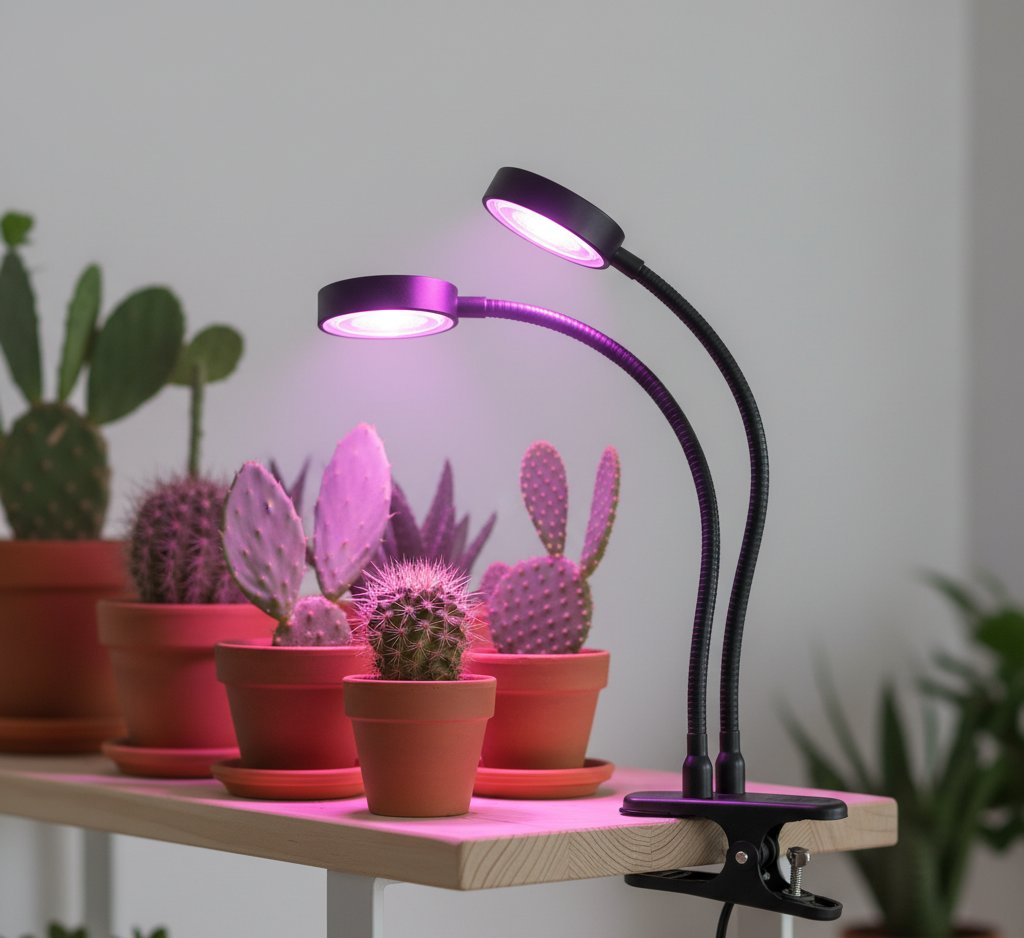

Clip-on grow lights attach to shelves, desks, or pots, making them space-efficient. You can adjust their flexible arms to direct light exactly where your cactus needs it. This design works well for small collections or tight areas with limited surface space.
Standalone grow lights, such as floor or tabletop lamps, offer greater stability and wider coverage. They’re useful if you have several cacti or larger pots that need consistent lighting. Many models include adjustable height and brightness controls for fine-tuning exposure.
| Feature | Clip-On Light | Standalone Light |
|---|---|---|
| Space Use | Minimal | Requires floor or table space |
| Adjustability | High (flexible arm) | Moderate to high |
| Best For | Small areas, single plants | Larger setups, multiple plants |
If you move your plants often, clip-on models give more flexibility. For a fixed indoor garden, larger standalone fixtures generally provide broader, more stable illumination, though light output depends on the bulb’s specifications, not just the fixture type.
LED Versus Fluorescent Lighting
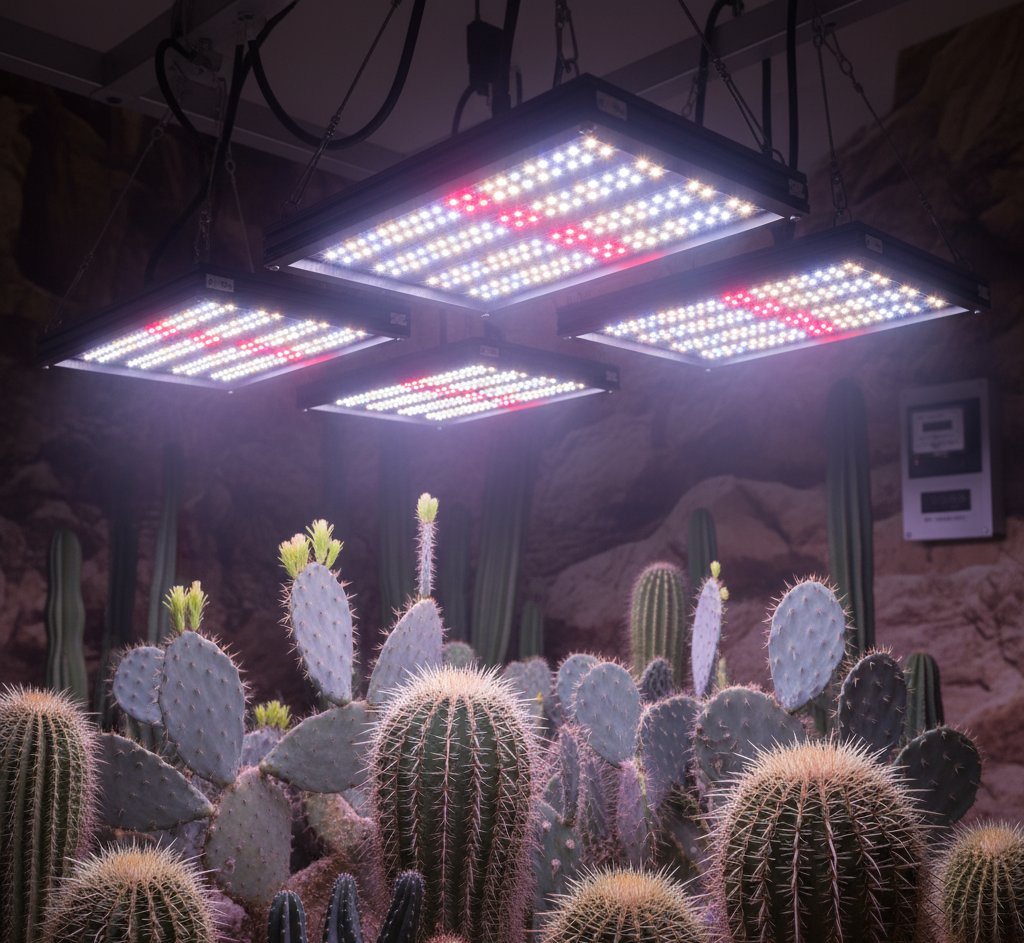
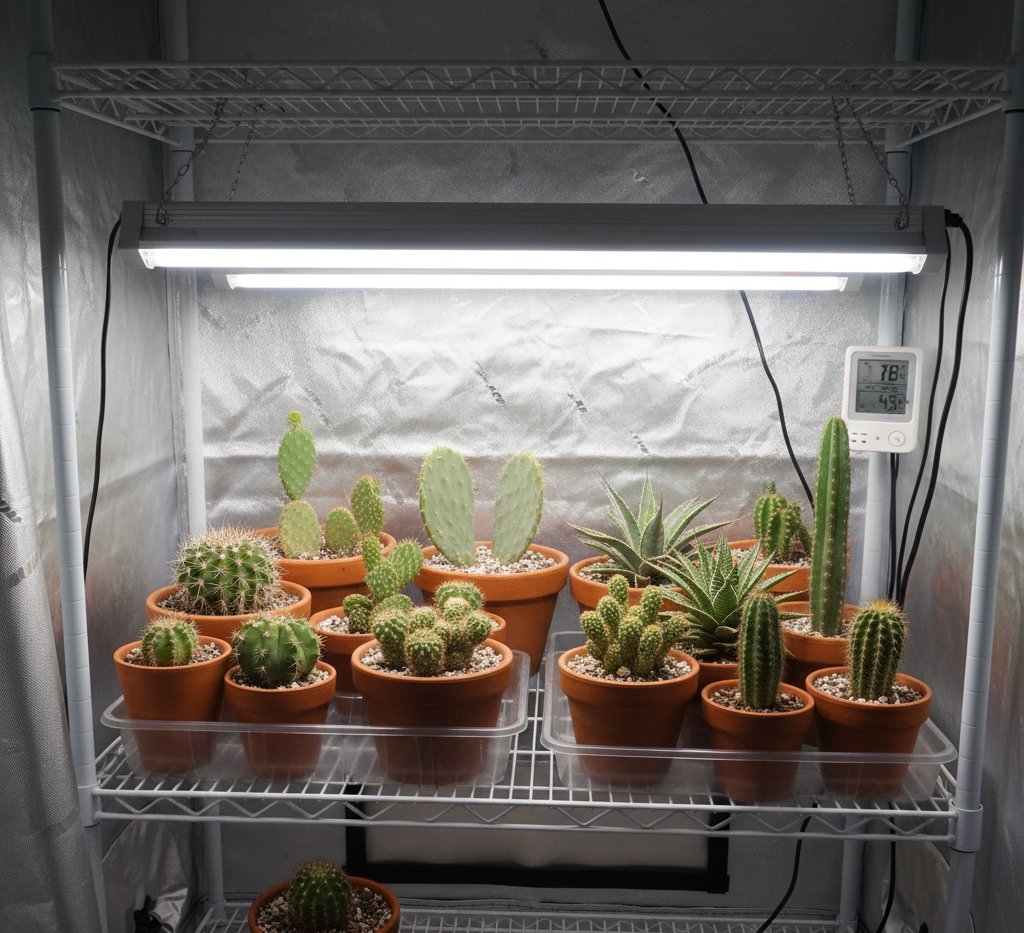
LED grow lights are efficient and long-lasting. They produce less heat, which reduces the risk of burning cactus tissue. Many LED options offer a full spectrum that mimics sunlight, supporting photosynthesis and balanced growth. LEDs also use less energy over time, lowering electricity costs.
Fluorescent lights, such as T5 or compact bulbs, give off a lower light intensity that works well for seedlings and small cacti. However, they are less energy-efficient (generating more heat per output) and need replacement more often.
| Type | Energy Use | Heat Output | Lifespan | Spectrum Range |
|---|---|---|---|---|
| LED | Low | Low | Long | Full spectrum |
| Fluorescent | Moderate | Higher (less efficient) | Shorter | Limited |
If you want a low-maintenance and efficient setup, LEDs are the better long-term choice.
Single Versus Multi-Head Designs
Single-head lights focus light on one plant or a small group. They’re simple to position and ideal for compact spaces. A single lamp can provide strong, direct light, but coverage is limited.
Multi-head grow lights feature two or more adjustable arms. This design lets you angle each head toward different cacti, ensuring even lighting across several pots. Many clip grow lights use this setup for flexibility.
| Design | Coverage | Flexibility | Ideal Use |
|---|---|---|---|
| Single-Head | Focused | Simple | One plant |
| Multi-Head | Wider | Adjustable | Multiple plants |
If you need a flexible way to light multiple individual cacti, multi-head lights provide the needed adjustable focus.
Frequently Asked Questions
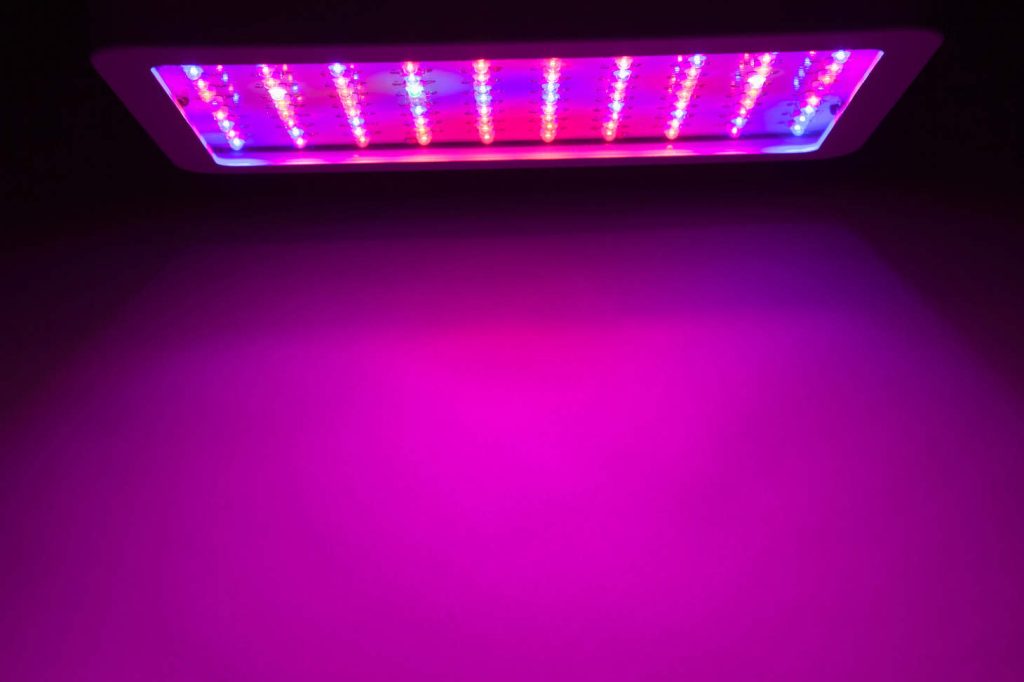
Cactus plants need strong, balanced light that mimics natural sunlight. The right spectrum, intensity, and distance between the light and the plant help maintain healthy growth and may even support flowering indoors.
What type of grow light spectrum is ideal for cactus plants?
Cacti grow best under full-spectrum or broad-spectrum LED lights that include both blue and red wavelengths. Blue light supports compact, sturdy growth, while red light encourages blooming and overall vitality. A color temperature around 5000K to 6500K most closely matches natural daylight.
How many hours of artificial light do cacti need per day?
Most cacti need 12 to 14 hours of artificial light daily to stay healthy. You can reduce this slightly in winter to mimic seasonal changes. Using a timer helps maintain a consistent light schedule without overexposure.
Can LED lights be effective for growing cacti indoors?
Yes, LED grow lights are highly effective for indoor cacti. They provide the right light spectrum, produce less heat, and use less energy than fluorescent or incandescent bulbs. LEDs also last longer, making them a practical choice for year-round use.
What is the recommended distance between grow lights and cactus plants?
Keep LED grow lights about 12 to 24 inches above your cactus, depending on the light’s intensity. Too close can cause heat stress or sunburn, while too far reduces light efficiency. Adjust the height if you notice stretching or pale coloration.
How do grow light wattage and intensity affect cactus growth?
Light intensity affects how efficiently your cactus photosynthesizes. For small setups, 20 to 40 watts per square foot usually provides enough brightness. Higher wattage or stronger lights support larger collections but should be monitored to avoid overheating.
Are there specific grow lights that are better for cactus flowering?
Cacti that bloom indoors respond well to lights with a slightly higher red light ratio. Some full-spectrum LEDs include a “bloom mode” that enhances red wavelengths, promoting flower development. Consistent lighting and proper seasonal cues also help trigger flowering.

